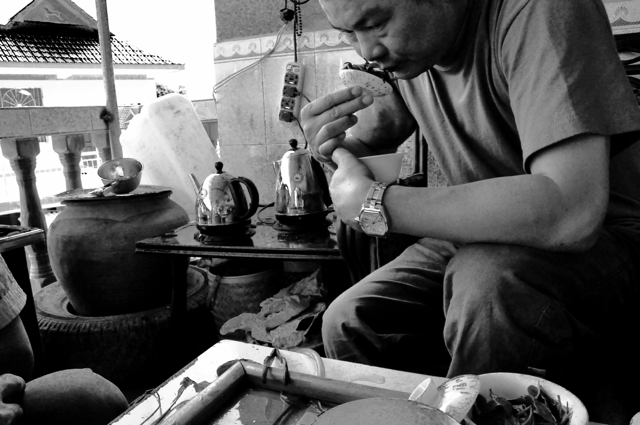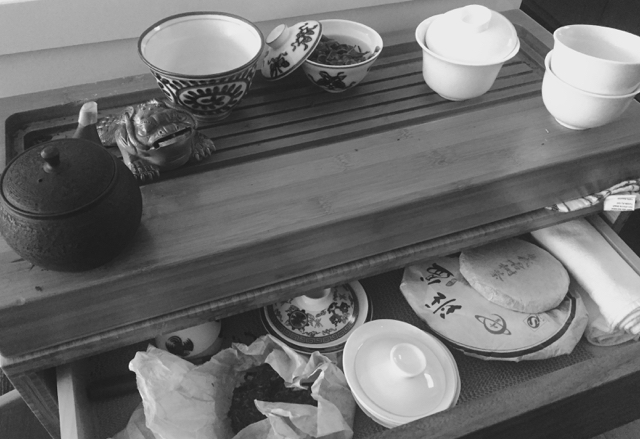“Forget about worrying about age. Forget it! If a tea isn’t made well, it isn’t going to become better. It is just going to age”.

Teacher, Provocateur and wonderful palate for all things tea…at work in one of his many playgrounds: the Bulang Mountains
One of the many voices that have counselled and often chided me comes from Mr. Li from Guangdong. Buyer of exceptional teas throughout China for collectors for decades, he runs a teashop that specializes in teas that are simply out of most people’s price range. “Aged” teas was one of his great peeves and discussion points. He raged against pricing a tea simply based on an apparent age of tea. Instead, he was an advocate on knowing a teas’s origins and knowing it was made simply with a good pair of hands belonging to a tea-mind.

Part of the wrap…though the wrappers can be misleading and outright lies. A wrap is just that whereas the storage for tea is a vital
Travelling with him throughout the years, I was gifted a particular treat one year when I joined him for a ten day tour with him through the Puerh tea regions of southern Yunnan years ago. He was – and continues to be – a rough-hewn sage on all matters life, but particularly tea. We spoke about tea, dismissed much that was tea related, and obsessed upon what made good teas good: good hands and great raw materials.

Bada 2007 Old tree cake at first glance. Not an overly tight compression but ideal for ageing as oxygen can circulate.
What was beautiful was that he simply enjoyed sharing knowledge and wasn’t the least bit interested in trying to sell me anything. It was about popping some predisposed bubbles about tea and hype. It remains the most productive and instructive tea episode I’ve been on the receiving end of.
“A good tea is above all other things, simple”. That was it for him. The sum of decades of tasting and making the leaf every single season was the word “simple”. It was with him that I ‘procured’ teas for my own enjoyment based on his words and gentle pushings. That was almost a decade ago and many of those little procurements only now (according to his recommendations) are getting some sampling.

An unveiling and an overview of the tea cake. Lighter coloured end buds are sliding into darker tones.
His face, like those of mentors or disruptors in life, appear often in tea related activities and when his provocative words come, they come full force into my mind.
It is his nonchalant way of speaking that arrives as I unfurl and prepare a Bada Mountain raw ‘Sheng’ Puerh cake from 2007, that reminds me why I acquired the cake in the first place. “This is a good tea and it will remain a good tea for a very long time”. Mr. Li was the very virtue that which he proclaimed a good tea should be: simple. He knew teas and found no reason to be overly stressed about who knew it.
Bada Mountain is a sanctuary of old tree forests and the handling skills of the local Hani has been consistent. I bought the cake along with about a dozen others that he recommended to me from different mountains and communities. Many cakes were consumed in the interim but many from that particular sojourn still remain and I chisel off some compressed leaves once in a while to sip them and make note of what is encountered. The Bada is one of the rare ones that hadn’t yet been sampled or ruffled from its little sleep.
Another one of Mr. Li’s mantras was that every single palate would encounter a tea slightly differently, so what was a ‘good’ tea had to be pinned down, otherwise the subjective palates of all would dictate what was “good” or “bad”. He spoke of three concepts again and again for raw Puerhs. In his frame of reference (and subsequently in mine) the notions of a clean and definable flavour with clear nectar, and he was absolute in his advocating that Sheng ‘raw’ naturally aged Puerhs should possess a little bit of ‘苦’ (‘ku’ or ‘bitterness’ in Mandarin) when it hits the mouth (but subsequently trails softer when swallowed), and lastly he mentioned his well-repeated comment to “forget about worrying about age”. In his views, the leaves’ quality was more important before the ‘age’ of a tree or cake.
My own little tea table hosts this little series of sips with the Bada cake that finally gets unfurled. Mr. Li often espoused the virtues of sipping the first infusion, when one was certain of its source rather than rinsing. Unveiling the cake, the wrap crinkles open in folds and there the compressed cake sits. Leaves from old trees in semi-states of dormant fetal state. Many more stems are visible than in more recent harvests but that is as much about the aesthetic as anything. Stems carry tannins and flavours and their existence is nothing suspect. The light buds have turned a slightly apricot shade with time.
Much is made of teas that are ‘apparently’ decades old. Antiquity in the tea world is as suspect as any, and genuinely old teas are difficult to prove…and beyond it all, not necessarily ‘better’. What is stimulating in the Puerh world is to sample a tea throughout its natural ageing process when it is in those moments of change and comparing those notes to a previous tasting.
My own Bada sampling, which is done alone, upon one of my old tea tables is a simple affair and the first infusion has a copper tang as the tannins have morphed and gone from green vegetal into something more akin to a mineral set of taste markers. The tea is going dark and the flavour cuts cleanly with iron tones that penetrate the molars and go deep in the mouth. A kind of astringency cuts before giving way (as Mr. Li always emphasized ‘should’ happen) as the liquid departs the mouth. Second and third infusions followed in slow time and they please in that the tones are alive and in the very midst of big shifts towards their darker naturally aged versions.
It is this ‘in-motion’ that is special. It is a tea on the move with the volatile elements within taking part in this movement.
The sips continue and go on and continue to unfurl. Michel de Montaigne the thinker, humanist and skeptic wrote “Why in judging a man do you judge him all wrapped up in a package?”, he continues …”you must judge him by himself, not by his finery”….and so it goes perhaps with tea too. That the tea itself on its own and out of its wrap and with a memory of a time and place is at its best.





Thanks for sharing this amazing article and I think this article is better than other published posts on another website.and love to share this article with my blogger friends.